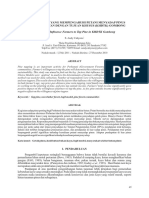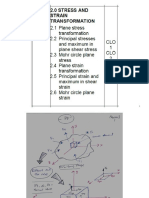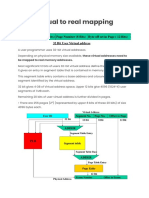Bedir Halcı, İsmet Yıldırım and Osman Korkaç: Control of Linear Motors Using Brain Signals
Bedir Halcı, İsmet Yıldırım and Osman Korkaç: Control of Linear Motors Using Brain Signals
Uploaded by
Bedir HalcıOriginal Description:
Original Title
Copyright
Available Formats
Share this document
Did you find this document useful?
Is this content inappropriate?
Report this DocumentCopyright:
Available Formats
Bedir Halcı, İsmet Yıldırım and Osman Korkaç: Control of Linear Motors Using Brain Signals
Bedir Halcı, İsmet Yıldırım and Osman Korkaç: Control of Linear Motors Using Brain Signals
Uploaded by
Bedir HalcıCopyright:
Available Formats
Control of Linear Motors using Brain Signals
Bedir Halcı, İsmet Yıldırım and Osman Korkaç
Marmara University, Istanbul, Turkey
Abstract
卐 This project is about position control of linear motors with filtered and processed brain waves as controller signals. System can be
generalized with mechanical movement-limited stages in a sense that active control is realised with electromechanical relations.
Introduction
卐 Electricity is found throughout human body. But nowhere in the body has an electrical activity better than the brain, which contains
roughly a hundred billion electrically conductive, biological wires. The brain consumes approximately 20% of the body's energy. It
consumes energy at 10 times the rate of the rest of the body per gram of tissue. The average power consumption of a typical adult is
100 Watts and the brain consumes 20% of this making the power of the brain 20 W. There is a equation below to show that
scientifically based on a 2400 calorie diet.
卐 2400 "food calorie" = 2400 kcal → 2400 kcal/24 hr = 100 kcal/hr = 27.8 cal/sec = 116.38 J/s = 116 W → 20% x 116 W = 23.3 W
Motivation & Principles Logic & Circuitry
卐 It is known that some universities have a graduate degree about 卐 We designed a circuit to use signals from brain (after a specific
brain signal process and electricity and it is predictable that many filtration and elevation) as a controller input for linear machinery.
countries try to use that power, secretly or not. In October 2018,
scientists connected the brains of three people to experiment with
the process of thoughts sharing. Five groups of three people
participated in the experiment using EEG(electroencephalogram).
The success rate of the experiment was 81%. But that power did
not find out recently. According to the records, at the late of
nineteenth century, some scientist tried electroencephalography
on animals.
卐 An electroencephalogram (EEG) is a test that detects electrical
activity in a brain using small, metal discs (electrodes) attached
to your scalp. And its firstly used in human body by Hans Berger,
at the year 1924. Nowadays, an EEG is useful for detecting brain
tumour, brain damage from head injury, strokes, brain network
analysis, brain-to-brain interaction, neurorobotics and much
more. It can also determine changes in a brain activity to
understand sleep disorders. Below is an example of what an
EEG recording looks like.
References
† Andrzejak, R.G., Lehnertz, K., Mormann, F., Rieke, C., David, P., and Elger, C. E.(2001) ‘Indication of Non Linear Deterministic and
Finite-Dimensional Structures in Time Series of Brain Electrical Activity: Dependence on Recording Region and Brain State’, Physical
Review E, Vol. 64, 061907.
† Buzsaki, G. (2006) Rhythms of the brain, Oxford, Oxford University Press.
† U. Brahms. Regelung von Lineardirektantrieben fur Werkzeugmaschinen ¨ . PhD thesis, Universitat¨ Hannover, 1998. VDI-Verlag,
Reihe 8, Nr. 735.
You might also like
- 660 Rev 29Document1,110 pages660 Rev 29truckman1000100% (4)
- Adubeus's Tower: A Home Long LostDocument8 pagesAdubeus's Tower: A Home Long LostDeivi CruzNo ratings yet
- Krav Maga Guide PDFDocument6 pagesKrav Maga Guide PDFDavid Priestley100% (6)
- World University of Bangladesh: Report On Radiography of The Brain (EEG)Document10 pagesWorld University of Bangladesh: Report On Radiography of The Brain (EEG)EmonNo ratings yet
- Brain-Computer Interface (Bci)Document16 pagesBrain-Computer Interface (Bci)Amal Raj ANo ratings yet
- Biological Bases of Behaviour.: Lecture 7: Techniques For Understanding Brain Structure & FunctionDocument22 pagesBiological Bases of Behaviour.: Lecture 7: Techniques For Understanding Brain Structure & FunctionVijendraAgarNo ratings yet
- Neural Basis of Behavior Methodology 23022023 013817pmDocument55 pagesNeural Basis of Behavior Methodology 23022023 013817pmفقير نقشبندي مجددي حسنيNo ratings yet
- Fundamental of EEG MeasurementDocument12 pagesFundamental of EEG MeasurementRyna Aulia Falamy100% (1)
- Seminar ON Brain Machine InterfaceDocument16 pagesSeminar ON Brain Machine Interfacenaina_cutieNo ratings yet
- EEG Based Machine Control: Department of Electronics and Communication EngineeringDocument4 pagesEEG Based Machine Control: Department of Electronics and Communication EngineeringShoaib MughalNo ratings yet
- Intro To Neurons and Eegs Brendan Allison, Ph. D. Bci Class Lecture #2Document26 pagesIntro To Neurons and Eegs Brendan Allison, Ph. D. Bci Class Lecture #2Rajesh ChaurasiyaNo ratings yet
- Paper On Brain Gate SystemDocument5 pagesPaper On Brain Gate SystemMGR0% (1)
- Review of Clinical EEGDocument200 pagesReview of Clinical EEGtuanamg66100% (10)
- Portable EEG Signal Acquisition SystemDocument8 pagesPortable EEG Signal Acquisition SystemcalsomoNo ratings yet
- Cyber WareDocument38 pagesCyber WareIbrahim KaithakkodanNo ratings yet
- Tinku Biswas, Swarup Sarkar, Akash Ku. Bhoi, Surajit BagchiDocument7 pagesTinku Biswas, Swarup Sarkar, Akash Ku. Bhoi, Surajit BagchiInternational Journal of computational Engineering research (IJCER)No ratings yet
- Tools To Study The BrainDocument23 pagesTools To Study The BrainFallon WallNo ratings yet
- A Seminar On ElectroencephalographyDocument18 pagesA Seminar On Electroencephalographyshubham kanthedNo ratings yet
- Analog VLSI and Biological Systems: RLE GroupDocument4 pagesAnalog VLSI and Biological Systems: RLE GroupsepritaharaNo ratings yet
- Brain Machine Interface (BMI)Document11 pagesBrain Machine Interface (BMI)Surajit PatiNo ratings yet
- Wavelets For EEG AnalysisDocument17 pagesWavelets For EEG AnalysisviditshopNo ratings yet
- ElectrophysiologyDocument32 pagesElectrophysiologyAbdelrehim Siraj100% (1)
- ElectrophysiologyDocument32 pagesElectrophysiologyAbdelrehim Siraj100% (8)
- Artificial Neural Networks Notes Syllabus Unit-1Document24 pagesArtificial Neural Networks Notes Syllabus Unit-1Cherry GargNo ratings yet
- A Seminar Report On Brain Computer InterfaceDocument16 pagesA Seminar Report On Brain Computer InterfaceAnit SachdevaNo ratings yet
- Vital Signs Monitoring System For Patients.: Universidad Politécnica Salesiana Cuenca - Ecuador AbstractDocument12 pagesVital Signs Monitoring System For Patients.: Universidad Politécnica Salesiana Cuenca - Ecuador AbstractFreddy Valdez GarciaNo ratings yet
- Systemic Study of Devices Processing Electromagnetic Waves Application To Brain Waves and EmotionsDocument5 pagesSystemic Study of Devices Processing Electromagnetic Waves Application To Brain Waves and EmotionsInternational Journal of Innovative Science and Research TechnologyNo ratings yet
- Dasar - Dasar Electroencephalography (EEG) Bagi Riset PsikologiDocument24 pagesDasar - Dasar Electroencephalography (EEG) Bagi Riset PsikologiNismarajennaNo ratings yet
- Electricity Flow in The Human Brain Can Be Predicted Using The Simple Maths of Networks, New Study RevealsDocument4 pagesElectricity Flow in The Human Brain Can Be Predicted Using The Simple Maths of Networks, New Study RevealsAlexis Mervin SyNo ratings yet
- Compressive Wideband Power Spectrum Analysis For Eeg Signals Using Fastica and Neural NetworkDocument7 pagesCompressive Wideband Power Spectrum Analysis For Eeg Signals Using Fastica and Neural NetworkInternational Organization of Scientific Research (IOSR)No ratings yet
- Brain Computer Interface DocumentationDocument20 pagesBrain Computer Interface DocumentationCharipally Dhanush RahulNo ratings yet
- Ce RebeloDocument353 pagesCe RebeloThyaren Quinteros VillaNo ratings yet
- Eeg CT Mri EtcDocument17 pagesEeg CT Mri EtcSana chaudharyNo ratings yet
- FinalDocument39 pagesFinallinhptt14012000No ratings yet
- Intervention: Electrical Scalp Neurons BrainDocument25 pagesIntervention: Electrical Scalp Neurons BrainnikitatayaNo ratings yet
- Analysis of Fractal Electrodes For Efficient Neural StimulationDocument10 pagesAnalysis of Fractal Electrodes For Efficient Neural StimulationSai Santhosh ManepallyNo ratings yet
- FMRI, MEG, PET, EEG - Descriptions of ProceduresDocument2 pagesFMRI, MEG, PET, EEG - Descriptions of Proceduresjovanb1No ratings yet
- 185 - Semiconductors in Medical ApplicationsDocument44 pages185 - Semiconductors in Medical ApplicationsRomar Angelo Avila100% (1)
- Cognitive Neurophysiology of The Prefrontal CortexDocument25 pagesCognitive Neurophysiology of The Prefrontal CortexLuís PachecoNo ratings yet
- BrainGate TechnologyDocument10 pagesBrainGate Technologysirraj2705No ratings yet
- Project Report On EEG MachineDocument26 pagesProject Report On EEG Machineneetubansal60% (5)
- BCI EssayDocument3 pagesBCI EssayShawnNo ratings yet
- 14-Brain Imaging-08-07-2022 (08-Jul-2022) Material - I - 08-07-2022 - Brain - ImagingDocument21 pages14-Brain Imaging-08-07-2022 (08-Jul-2022) Material - I - 08-07-2022 - Brain - Imagingfiseha tadesseNo ratings yet
- Neurosky TechnologyDocument23 pagesNeurosky TechnologyTejasriVarma100% (2)
- Biomedical Engineering Ktu Mod 3Document12 pagesBiomedical Engineering Ktu Mod 3Adheeb Shibu VattasserilNo ratings yet
- Portable Wireless Electrocorticography System With A Flexible Microelectrodes Array For Epilepsy TreatmentDocument8 pagesPortable Wireless Electrocorticography System With A Flexible Microelectrodes Array For Epilepsy TreatmentprvthesapNo ratings yet
- Brain Computer InterfaceDocument11 pagesBrain Computer InterfaceShashank BijweNo ratings yet
- EEG StressDocument16 pagesEEG StressRavi ChanderNo ratings yet
- EEG Backgnd HistoryDocument5 pagesEEG Backgnd Historyzelin99No ratings yet
- BBOC407 - Module 3Document23 pagesBBOC407 - Module 3nida61325No ratings yet
- Ieeepaper RaviDocument6 pagesIeeepaper Raviㅤㅤ JitNo ratings yet
- Your Heads BatteryDocument3 pagesYour Heads BatteryAnonymous TL6DhwK8mXNo ratings yet
- A Hierarchical Artificial Retina ArchitectureDocument14 pagesA Hierarchical Artificial Retina ArchitectureHRC100% (1)
- FinalDocument39 pagesFinalAmeerNo ratings yet
- Analysis and Simulation of EEG Brain Signal Data Using MatlabDocument11 pagesAnalysis and Simulation of EEG Brain Signal Data Using MatlabAsmaa MosbehNo ratings yet
- EEG and BrainDocument110 pagesEEG and BrainGeo MeNo ratings yet
- BiopacDocument8 pagesBiopacAdrian GallegosNo ratings yet
- Paper Presentation On Embedded Systems: Done By, C. Aravind, S. Nageswaran, Maharaja Engg. College, AvinashiDocument15 pagesPaper Presentation On Embedded Systems: Done By, C. Aravind, S. Nageswaran, Maharaja Engg. College, AvinashiAravindebooksNo ratings yet
- Presented by K.Avinash Reddy CH - Suma SwathiDocument17 pagesPresented by K.Avinash Reddy CH - Suma Swathianuhyareddy1991_4408No ratings yet
- Closed-Loop Neuroscience and Neuroengineering: Neural CircuitsDocument3 pagesClosed-Loop Neuroscience and Neuroengineering: Neural Circuitsimranq02No ratings yet
- BCI CorrectedDocument3 pagesBCI CorrectedSukan AarushNo ratings yet
- Parasitology Lab ManualDocument33 pagesParasitology Lab ManualshericeNo ratings yet
- HR ReportDocument13 pagesHR ReportAashish MalhotraNo ratings yet
- Pizza ManagmentDocument97 pagesPizza Managmentanish_1067795360% (10)
- HRIS Metrics Case StudyDocument2 pagesHRIS Metrics Case Studysupriya sonkusareNo ratings yet
- Study of River EcosystemDocument16 pagesStudy of River EcosystemIshanShikarkhane40% (5)
- Accelerating Growth - Strategic Approach On Dynamic Pricing in BankingDocument2 pagesAccelerating Growth - Strategic Approach On Dynamic Pricing in BankingsuntecsolutionssNo ratings yet
- Cuadernillo de Ingles.Document16 pagesCuadernillo de Ingles.yancarlosSMNo ratings yet
- Mm-Yyyy: Form No.: Revision No.: 001 Effective DateDocument3 pagesMm-Yyyy: Form No.: Revision No.: 001 Effective Dateafi puccaNo ratings yet
- Chapter 8 Lecture Notes: Lipids: Polyunsaturated Fatty Acid Structures Differ From One AnotherDocument26 pagesChapter 8 Lecture Notes: Lipids: Polyunsaturated Fatty Acid Structures Differ From One AnotherMarinelle TumanguilNo ratings yet
- Guide To Rural England - WorcestershireDocument38 pagesGuide To Rural England - WorcestershireTravel Publishing100% (2)
- Faktor-Faktor Yang Mempengaruhi Petani Menyadap PinusDocument8 pagesFaktor-Faktor Yang Mempengaruhi Petani Menyadap Pinusarpal batuNo ratings yet
- 1091 Circuit Theory HW2 Solution: Magnitude A JB A B B Phase A JB Add Ifa B Subtract Ifa B ADocument6 pages1091 Circuit Theory HW2 Solution: Magnitude A JB A B B Phase A JB Add Ifa B Subtract Ifa B A曾燒餅No ratings yet
- DP2 Anchor Handling Tug Supply Vessel For SaleDocument2 pagesDP2 Anchor Handling Tug Supply Vessel For SaleVladi GasperNo ratings yet
- Novel in A Month Notebook Eva DeverellDocument21 pagesNovel in A Month Notebook Eva Deverellhannah100% (1)
- Chapter 2Document50 pagesChapter 2iffahNo ratings yet
- Quiz-1 Course: HRM-380Document6 pagesQuiz-1 Course: HRM-380NahidulNo ratings yet
- Factors Influencing Senior Citizens' Walkability in Rural ThrissurDocument11 pagesFactors Influencing Senior Citizens' Walkability in Rural ThrissurRamiz AkhtharNo ratings yet
- ISSUEff23 Megadahlia Lap Rug Knitty - Com - First Fall 2023Document2 pagesISSUEff23 Megadahlia Lap Rug Knitty - Com - First Fall 2023Ari HgogNo ratings yet
- Weeds ReportDocument9 pagesWeeds ReportEs-teling TalingNo ratings yet
- Virtual To Real MappingDocument3 pagesVirtual To Real MappingAditi JindalNo ratings yet
- Social Studies Lesson PlanDocument3 pagesSocial Studies Lesson Planapi-219095854No ratings yet
- Settlement For Cohesive SoilDocument9 pagesSettlement For Cohesive SoilQuach TuanNo ratings yet
- Web ProgrammingDocument16 pagesWeb ProgrammingsirnesateshomeNo ratings yet
- ﻲﻫ Three وأ 3 تﺎﻜﺒﺷ ﻦﻣ ﺪﻳﺪﻌﻟا: Britney Spears - 3 (Official Music Video) - YoutubeDocument3 pagesﻲﻫ Three وأ 3 تﺎﻜﺒﺷ ﻦﻣ ﺪﻳﺪﻌﻟا: Britney Spears - 3 (Official Music Video) - Youtubeفادي بطرسNo ratings yet
- LP For Final DemoDocument8 pagesLP For Final DemoAiah Rica SumalinogNo ratings yet
- Schöll - Lens - Instability Phenomena in Interconnected Power SystemsDocument7 pagesSchöll - Lens - Instability Phenomena in Interconnected Power Systems程浩真No ratings yet
- REDRAGON Distributers 14.3.2021Document52 pagesREDRAGON Distributers 14.3.2021Ahmed Abd ElwanessNo ratings yet

























































































